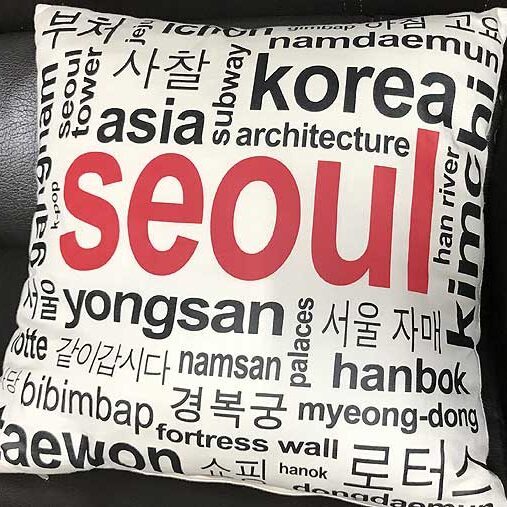Do I need an adapter or transformer?
And what’s the difference between an adapter and a transformer?

One of the most frequent questions from people traveling to Korea is how they will be able to use their computers, tablets, chargers, shavers, etc. The good news is, it’s not that difficult. Your concerns are just two things:
- The physical designs of the plugs and sockets
- The electric power characteristics
The quickest way to look at this is “can my things’ AC plugs fit into their sockets, and will they blow up when I plug them in?”
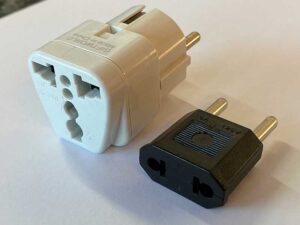
Plugs and sockets are easy. There are charts that show who and where uses what kind and it’s easy to buy inexpensive little adapters to mate one type of plug to a different type of socket (also called receptacle), such as the two shown here for Korean sockets. But those little things don’t change the electricity. They just help you move it from the wall to the appliance.
The electricity takes a little more thought. Again, there are many charts published that show who uses what. In general we’re going to begin with the voltage of the power and tell you that you can consider almost anything from 100V and 120V the same, and you can consider 220V through 240V the same. But a 100-120V (only) device must never be plugged into a 220-240V socket without a transformer or converter, and a 220-240V -only device also will need at least a transformer in a 110-120V country.
There is one additional wrinkle that could affect visitors to Korea from some countries and that is the frequency of the power (always either 50 Hz or 60 Hz).
Devices with motors, some clocks, etc. can be picky about frequency, and so can some devices with older (non-“switching”, usually more than ten years old) power supplies. If there is frequency related trouble to be had, it is usually from using a 60 Hz device on 50 Hz power. Korea’s power is 60 Hz, so you may not have to be too concerned.
If you’re not certain about your country’s electricity standards and Korea’s, I found a fairly comprehensive list over at Generator Source. (Disclaimer: We do not guarantee the accuracy of that list.) And you may safely ignore the column for three-phase power unless you’re importing an electric car or a clothing dryer.
What does a transformer do?
A transformer alters the voltage of electricity, and possibly the physical type of plug/socket connections too. There are two transformers in the picture below. The one on the left is similar to what we provide in our apartments. That one is a step-down transformer rated for 1,000 VA (1 KVA) and the example on the right handles only up to 200 VA. Note the North-American Type-B outlets (grounded) on the left and Type-A on the right (two blade, no ground), with Type-C and Hybrid plugs shown between them meant for use with Korean AC sockets.
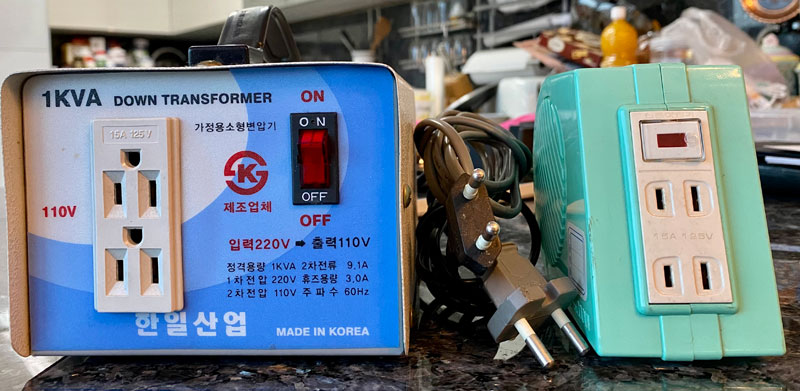
At Hannam BnB we provide at least one “step down” transformer (meaning it converts voltage down from ~220V to ~110V) in all of our apartments and can provide more if necessary. We recommend guests bring their own adapters but we supply two adapters for Type-A (US, etc.) plugs, with more including a handful of international adapters available upon request.
Transformers and adapters cannot change electricity’s frequency. For that you need a more expensive electronic device called an inverter or converter. We do not supply converters for our guests and currently have none on hand.
Physically, Korea’s wall outlets are “Type-C” (two-prong) and “Type-F” or “Schuko” (two-prongs and a ground connection). In contrast, places like the United States for example rely on NEMA standard (“Type-A” and “Type-B”) outlets.
More About Electricity
Korea’s household electrical standards are 220 Volts and 60 Hz. If you’re not familiar with the technical terms, think of Volts or voltage as a measure of pressure (like the force of water through a garden hose and how far it can spray). The “Hz” figure (short for Hertz, also described as cycles) describes the frequency (number of times per second) that the direction of the AC power (alternating current) switches direction. Yes, AC power really goes back and forth in the wires fifty or sixty times per second.
If you need a transformer, you also may need to consider Watts, which is a value describing how much power you need to handle. Back to the plumbing analogy, wattage may be thought of as the overall amount of water flowing through the garden hose – a factor of pressure and volume. What’s important to know is that if you use a 2,000 Watt appliance through a transformer that is only rated for up to 500 Watts, you can damage both the transformer and possibly the appliance too.
Consumer devices are usually rated in Watts while transformers are often rated in VA or “Volt-Amperes” instead of Watts. For AC current these are not really identical values but that discussion is very complicated, so for our purposes we’re going to say it’s the same thing. KVA means 1,000 Volt-Amperes, so you can think of a 2 KVA rating as roughly 2,000 Watts.
The good news is that most of the gadgets you’ve bought in the last few years probably don’t care what AC voltage or frequency they’re plugged into. But a good general rule to follow is that if you have a gadget or appliance with a motor or a heating element, or both, like a hair dryer, it will probably need a transformer if it was designed for a substantially different voltage, i.e. ~220 Volts versus ~120 Volts or the other way around.
Most computers, laptops, tablets, phones, shaver/trimmer chargers, streaming media and WiFi gadgets, etc. now use a type of AC power supply called a “switching” power supply, most of which can automatically cope with whatever voltage and frequency of AC power you plug it into. They are usually lighter, watt-for-watt than older types of power supplies which relied on heavy transformers made of copper and lots of iron. The labeling will reveal that they can adapt to almost any AC power you can connect them to.
On the laptop power supply pictured below, the red arrow points out the important part of the label. It indicates that you can connect it to any voltage between 100 and 240. The tilde (~) after the voltage indicates that expects an AC input current. The label also shows that it is compatible with either 50Hz or 60Hz.

But even though the above device is a “90W” adapter, that is only what it promises to be able to supply to the laptop. No adapter is 100% efficient, so plan on this one consuming around 30% more power (wattage). And for folks who find technology interesting, the input amperage range implies that this laptop AC adapter may be about twice as efficient when connected to higher voltage receptacles. (100×2.5=250W consumed, 240×0.5=120W consumed)

Older power supplies based on transformers, like the dusty “wall-wart” shown here used for charging a fifteen year old cordless screwdriver, usually cannot cope with any but one specific voltage (within the range mentioned above, meaning if it says 120 V, 110 V is OK too).
Note the red arrow points to where the brick specifies 120 V at 60 Hz ONLY. For this power supply and ones like it you MUST use a transformer to use it in Korea.
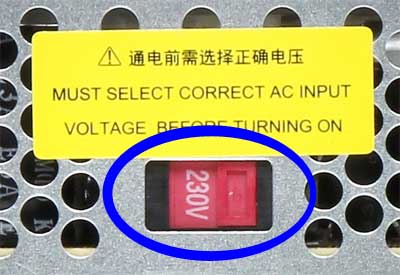
Larger electronics such as televisions, computers and printers may also be able to cope with different AC voltages and/or frequencies. But some may feature a switch that needs to be set, such as the slide switch circled in blue on this desktop computer power supply pictured. Again, always check the labeling on the device.
If you’re still not sure, ASK SOMEONE. The wrong guess can damage your belongings or even start a fire.
Shopping Tips
If you plan to stay someplace that doesn’t have the correct receptacles for the AC-powered gear you’re bringing, you may need to shop for adapters or a transformer or converter. We supply both transformers and adapters at Hannam BnB, though most of what we have is geared to North American visitors. Some hotels in Korea may have 120 V and international receptacles in their rooms, most often in the accommodations’ bathrooms. Call the hotel(s) in advance of your travel to find out!
When shopping for a transformer, for safety and reliability you should look for a transformer with a power rating that is greater than the wattage you’ll be using. For an 800 W hair dryer for example, look for at least a 1,000 VA transformer. For a 1,8750 W hair dryer don’t even think about less than a 2,000 VA transformer, and consider carrying something less powerful.
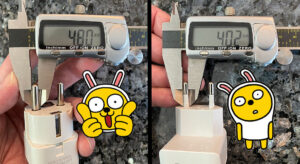
Lastly, a matter of Type-C or -SE versus “Schuko” and Type-F plugs. When shopping for adapters to use in South Korea, we suggest people look for adapters that specify use in Schuko or Type-F receptacles, or at least specify that their prongs are 4.8mm in diameter. Some adapters, particularly those made for use in much of Europe, use prongs that are only 4.0-4.5mm diameter and they sometimes do not make reliable electrical contact in Korean receptacles.
Can you take it with you?
If you fall in love with a Korean gadget or appliance, how will it work if you pack it and take it back to your home country?
Many of the same principles we discussed above apply here, but in reverse. If for example you are returning to the US where most receptacles are 110V @ 60Hz, then you need to check the markings on the device or its operating manual to find out if it is compatible with 110V power. If it can work on 110V, you may only need a small adapter to help make the physical connection into your wall receptacle.
Long-term, if the device uses an easily replaceable power cord you can buy one instead of using an adapter. Or you can cut the foreign plug from the original power cord and replace it with an appropriate domestic plug from a hardware store. We have replaced plugs or entire appliance cords for US appliances in Korea and for Korean appliances in the US.
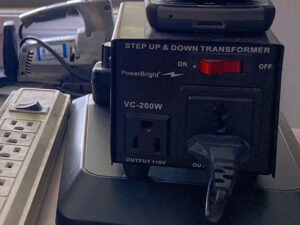
If the device is 220V only, and you are returning to a country that relies on 110V at the wall receptacles, then you will need to shop for an appropriate transformer such as the small one shown here being used with a Korean desk lamp.
The same exact rules about VA/KVA or wattage ratings apply. And remember to do all the math. If you’re going to use more than one device on the transformer simultaneously, add up the wattage and buy a transformer that is large enough for both. And either way, select a transformer with a little extra capacity in its power rating (maybe 20% or so?) to spare.
Safe travels!
